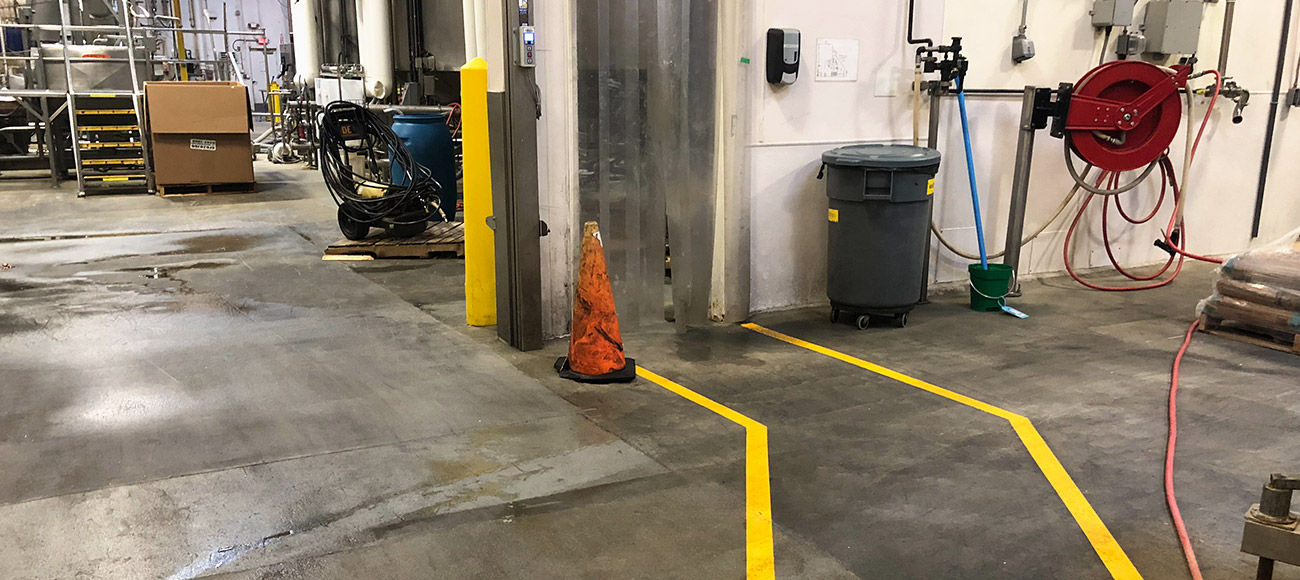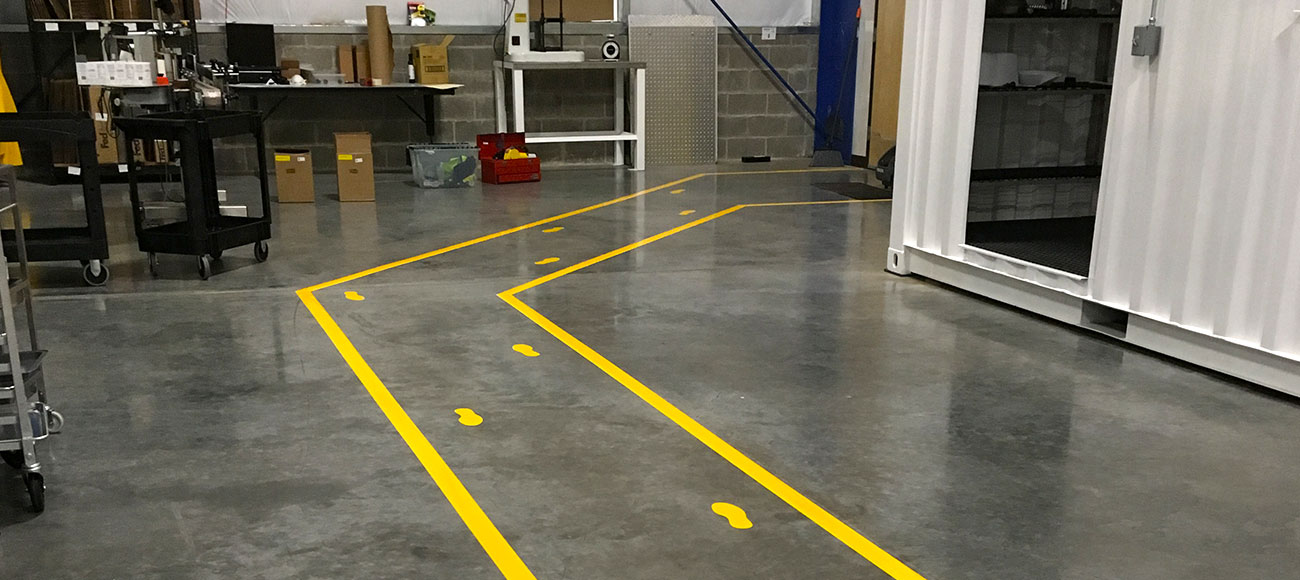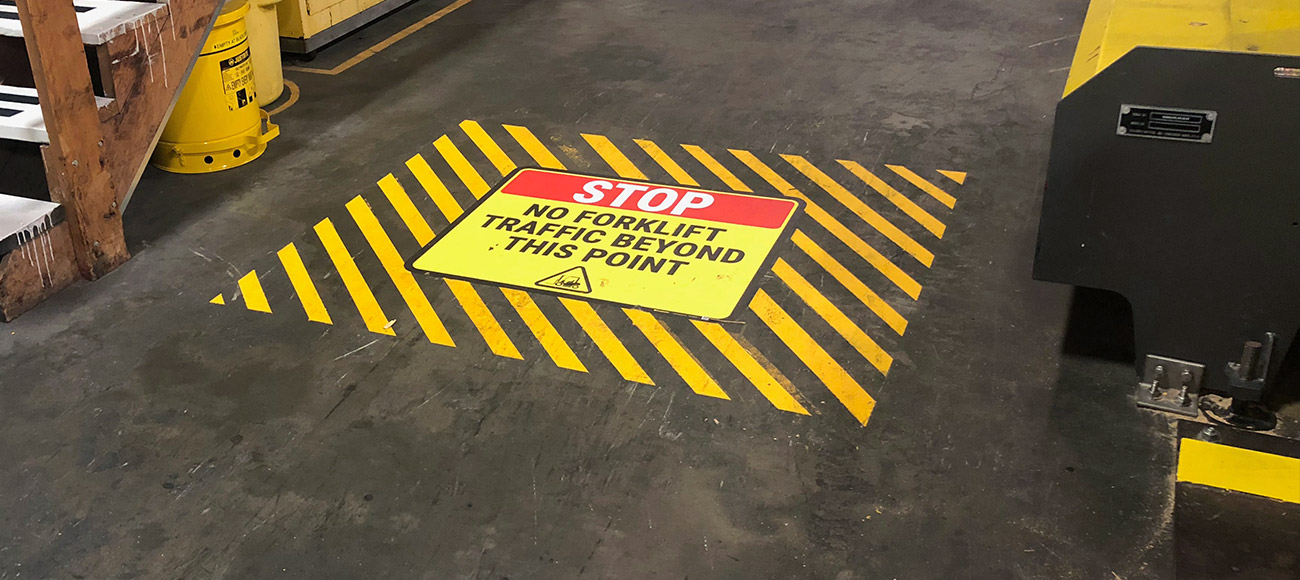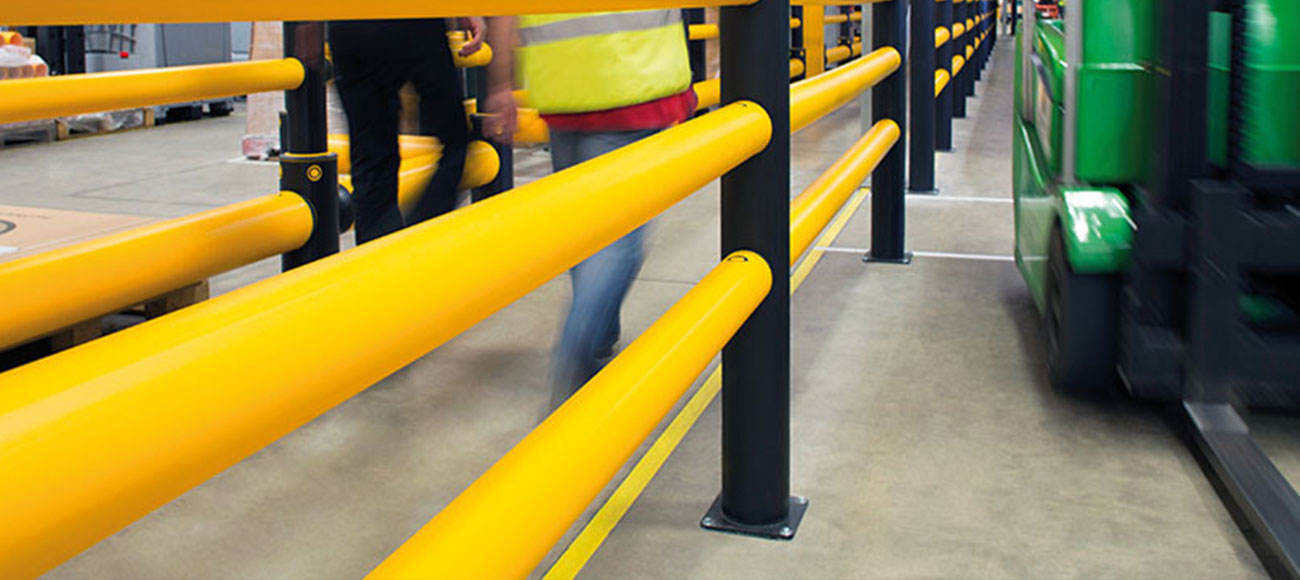
Marking the floors of your facility with highly visible floor marking tape or paints is a powerful way to identify area boundaries and proper object locations, direct pedestrian traffic, and draw attention to areas requiring extra attention for safety or operational reasons. This simple change can dramatically reduce accidents and improve site navigation.
Floor marking can be particularly important for safety in facilities that use forklifts- distribution centers, warehouses, manufacturing plants- where accidents between vehicles and pedestrians can occur. Accidents involving a forklift striking a pedestrian make up more than 25% of all forklift accidents and many of these could be prevented with appropriate floor marking and safety protocols. Proper floor marking means the difference between a facility where employees can wander through risky areas and a facility where pedestrians follow a prescribed path and protocol, protecting them from collision with operating forklifts.
The damage that forklifts can cause from being too close to racks and equipment can be catastrophic. You’ve undoubtably seen videos of forklifts striking legs of a rack and everything in a warehouse coming down in a domino-like chain reaction. Forklifts are also at risk of getting too close to the edge of a loading dock and tipping over. By marking safe clearance distances with bright, bold lines on the floor, forklift drivers can have an ever-present visual reminder of safe boundaries.
Ultimately, a well marked facility brings order and sends clear messages- There are paths to follow to stay safe. There are places things belong. Certain areas are dangerous.

Where is floor marking used?
Depending on facility and industry, there are a number of places where floor marking is often utilized:
- Loading docks
- Warehouse aisles
- Pedestrian safe walkways
- Crosswalks
- Forklift traffic zones
- Staging lanes
- Hazardous areas
- Electrical area boundaries
- Emergency paths
- Work cells
- Equipment charging areas
- 5S red tag areas
- Trip or slip hazards
- Materials storage
What floor marking colors should I use?
The goal of good floor marking is to create a highly visible, standardized system that is easy to understand at a glance. One of the biggest components of this is choosing the right colors.
Over the last few decades, a set of floor marking general color standards has emerged that have been adopted by thousands of companies across many industries. These colors and their meanings are detailed in the chart below.
Yellow
Aisleways
Traffic Lanes
Work Cells
White
Production
Racks & Machines
Carts
Benches
Red
Defect/Scrap Areas
5S Red Tag Areas
Orange
Inspection Areas for Products or Materials
Energized Equipment
Green
Finished Goods
Blue
Raw Materials
Black
Works-in-Progress
Yellow & Black
Areas which present imminent physical or health hazards
Red & White
Areas to be kept clear (Safety Protocols)
Black & White
Areas to be kept clear (Operations)
It is highly recommended that a chart of the colors used on your floors be posted in a visible location so employees can be reminded of the meanings of each color.

What width lines do we need?
OSHA specifies that lines for safety passageways be at least 2 inches in width. For large facilities, we recommend 3 inch or 4 inch lines for maximum visual impact.
Floor Marking Best Practices
Depending on facility and industry, there are a number of places where floor marking is often utilized:
- Be consistent with your markings and post a legend of the meaning of each color if multiple colors are used.
- Certain floor types can be difficult to work with, so it’s important to choose the right floor marking product for your floor.
- For optimal performance, it is recommended to not apply floor tapes directly over painted lines, as the adhesive will stick to the paint instead of the floor, compromising the integrity of the adhesive.
- When marking your floors indoors, it is recommended to use floor tapes or manual paint rollers as industrial paint striping equipment can be hazardous to air quality.
- To maximize the lifetime of your lines, use heavy duty floor marking tapes in areas with heavy forklift traffic including loading docks and staging areas. Paint can wear down over time with excessive wear and tear, and light duty tapes are prone to peeling and breaking up. Light duty to medium duty tapes are appropriate for areas that don’t see extended wear and tear from foot and equipment traffic.
- If using floor tapes, be sure they are being applied to a clean, dry floor that is free of oils and greases.
- Use floor signs and barriers for maximum communication of your messages.

What OSHA Says:
“OSHA requires that permanent aisles and passageways be free from obstructions and appropriately marked where mechanical handling equipment is used. [29 CFR 1910.176(a)]”. Consider separating pedestrians from lift trucks by providing:
- Pedestrian walkways,
- Permanent railings or other protective barriers,
- Adequate walking space at least on one side, if pedestrians must use equipment aisles,
- Pedestrian walkway striping on the floor, if barriers cannot be used."
https://www.osha.gov/SLTC/etools/pit/workplacehazards/pedestriantraffic.html
OSHA Standard 1910.176(a):
“Use of mechanical equipment. Where mechanical handling equipment is used, sufficient safe clearances shall be allowed for aisles, at loading docks, through doorways and wherever turns or passage must be made. Aisles and passageways shall be kept clear and in good repair, with no obstruction across or in aisles that could create a hazard. Permanent aisles and passageways shall be appropriately marked.“
https://www.osha.gov/laws-regs/regulations/standardnumber/1910/1910.176#1910.176(a)

You may consider: Floor Signs
One of the best ways to communicate specific messages on your floors is with floor signs. Floor signs or floor stickers are a perfect companion to floor marking lines, as they can display text and images to relay important safety or logistics information. Popular floor signs include stop signs, pedestrian crossing signs, exit signs, yield signs, and signs to mark zones and pallet locations.

You may consider: Barriers
Barriers act as a vertical extension of safety lines allowing you to physically separate volatile areas like material handling and transportation zones from vulnerable areas like pedestrian passageways, racks, and equipment. Barriers can provide a foolproof way to prevent collisions between forklifts and pedestrians and protect your assets from damage.
Free Floor Marking Color Code Wall Chart
Free download or get a copy by mail to hang on your wall.
